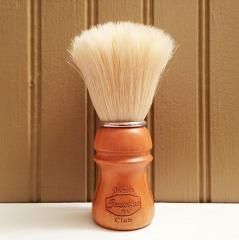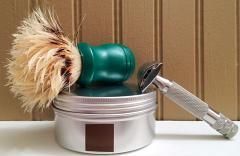Curing Common Shaving Brush Woes
New shaving brushes are awesome, aren't they? With some basic care, most will last many years and some perhaps, your lifetime. Sometimes though, they develop... Issues. With better brushes being as expensive they are, the idea of an early demise is not a welcome one. So let's take a look at some of the most common issues - and how to fix them!
I've covered Cleaning your DE razors in an older article, if that interests you.
Prevent Damage
Of course, preventing damage in the first place is always the best way to go. Here are some guidelines to help extend the life of your brush:
-
Always soak your natural hair brushes before use; at least a few of minutes. Synthetic brushes only require dipping.
-
Always allow your brush to dry in open air (not in a medicine cabinet) fully. Hanging upside with a stand is a plus.
-
Avoid excessive pressure on a brush; lighter is better. Splaying it on your face is fine - mashing it into a tub is not.
-
Avoid twisting back-and-forth motions (such as when loading from a tub). This can lead to whorls and broken hairs.
-
Never use water that exceeds the recommended standard for hot water - 120ºF. Hot is fine - boiling is definitely not.
-
Never just throw your brush in a dopp without a tube when you travel. All sorts of bad things can happen this way.
-
A few hairs falling out when new is normal, or every once in a (rare) while. Constant shedding indicates a problem.
Unruly Knots
The bristles of your brush may, over time and/or through improper use, develop a whorl (a type of spiral or circular pattern) or just go off in all sorts of directions, perhaps unevenly. This typically affects natural hair bristles like boar or badger - but can also manifest in synthetic knots. In fact, in the picture above you'll see a close up of a #Mühle XL Silvertip Fibre knot as found in a #BSB Shaving Brush. Granted, it's only slight - but these things are best resolved as early as possible. Thankfully, these can be simple, quick fixes.
Natural
Start with the gentle approach. Soak your brush for about 5-10 minutes or so in warm-hot (max 100ºF) tap water, or do this after your regular shave and rinsing. Either way, shake as much water out as you can and slide it down an empty toilet paper tube. Let the brush sit like this for most of the day, such as while you're at work. Fluff up when you return and let it dry fully before storage.
If you need a stronger action, use a hair tie, preferably (it won't grip the hairs like a rubber band) and loop it around the handle until there's just a slight tightness to it (just enough to pull the knot together). Roll it up the handle, over the knot and position it about 3/4 of the way up. Let the brush sit like this and fluff when dry as above. This should curtail massive blooming of the brush (such as the #SOC might and how you often see mine in my SOTD posts) and fix minor whorls. In the case of the former, it's a temporary fix - while the latter is more permanent... Unless you repeat what caused it in the first place. You may need to repeat this procedure a couple of times - and tighten the hair tie up a little if necessary.
If you just have a few wild hairs that stick out, stick with the empty toilet paper tube method.
Water will help to hydrate and soften the hairs, but by itself isn't enough as with synthetic knots. The binding - and time - is where the magic happens with natural hair knots.
Synthetic
Synthetic fibers used in brush knots have a lot of benefits. Besides quick drying, less consumption of product and not requiring soaking before use... They're easy to fix in cases like this. First, don't soak them before shaving - there's no need, and hot water will soften the fibers which invite issues like this.
The first approach would be getting the hottest tap water possible and letting the knot soak for 10 minutes or so. Then just stand the brush up, or hang it and let it cool naturally. If that doesn't help, or enough - try it again. If that fails too, it's time for drastic action.
As a last resort (or for more serious problems) we will be soaking in (just off) boiling water. Even the hottest tap water won't be enough, which generally peaks around 120-130ºF (if it's hotter, you have bigger issues). Get a pot, fill it with around 3" of water and bring it to a boil... When it does, it will be 212ºF - kill the heat, put on an oven mitt and grab your brush. Immerse it into the water (which will now be about 200ºF) knot down, about 3/4 of the way - keep the hot water away from the handle end as it may soften or damage the glue holding your knot in place! Keep the brush submersed for five minutes, moving it slightly on occasion to dislodge air bubbles and separate the fibers a little so that they kind of fall naturally in the water. Once the time is up, remove the brush, give it a minute and gently squeeze out the water. Form the knot into a bit of a point as you might a paintbrush and let it cool down fully and dry. Once dry, give it a sort of "fluffing up" with your hand and you should notice that it's nearly like new.
The high heat of the water will soften the fibers sufficiently so that they relax into their natural state (including the crimping, to a degree). Binding isn't necessary, but if you want to tighten up the knot you can. It'll take a bit of use and "pumping" during lathering to restore the original "fluff." This really is a last resort, and if it still doesn't work out - consider replacing the knot at this point.
Gunky or Funky
In the years I've been wet shaving, I've never had to clean a brush. Granted, I give my natural hair brushes a soak in a scuttle full of hot water before every shave, which tends to float off any remnants of soap. If you're a face latherer, you'll probably need to do this sooner or later. This is also useful if you have a new brush, one that's stained from a dark soap (such as those with a lot of vanillin) or just smells funky for whatever reason.
Natural
Soak your brush for about five minutes or so in warm-hot (max 120ºF) tap water, as you might before a shave. Squirt a drop or two of dish soap in your palm, take your brush and work the suds into it well. Continue this massaging, lathering action for a minute or two until it's really into the knot. Set it aside for five minutes. If it's still funky, mix up a white/apple vinegar/warm water solution in the ratio of 1:3. Rinse your brush from the previous step well, then set the brush in this solution and let it soak for another five minutes. Once complete, rinse it well, gently squeeze out the water and let it dry naturally.
Dish washing liquid is generally a bit harsh as far as soaps go, and is designed to break up oils and fats. The vinegar is more for funkiness, but can also help.
If you're lazy or in a rush, consider the Brush Rejuvenator soap from L&L Grooming.
Synthetic
Generally not needed, but if you have build-up then you can use the above dish soap procedure.
Coarse, Rough Knots
After a while, that once super plush badger brush might not really be all that soft anymore. The hairs may feel kind of dry, rough and somewhat stiff. These hairs, really, are not unlike those on your own head. They get dried out from (often daily) exposure to hot water, soap and abrasion. This can result in breakage and a less than ideal experience.
Natural
Soak your brush for about five minutes or so in warm-hot (max 100ºF) tap water, as you might before a shave. Remove, squeeze out the excess water and using a good amount of regular hair conditioner, massage it into the knot well. Make sure it's coated liberally and set it off to the side for about five minutes. After that, rinse it out very well and hang to dry. You'll notice that the knot feels much, much more pliable and soft! It'll probably also smell really nice. This is a rather temporary fix, so you'll probably want to repeat it every now and then or as a follow up to cleaning your brush (which is a harsh process).
While some may have a concern about build-up of conditioner (which depends on frequency of application and more so the conditioner itself) it isn't really a problem - because think about it; you're soaking your brush, loading it with soap and abrading it across your stubbly face probably daily. This will fix itself.
Synthetic
Does not apply.



